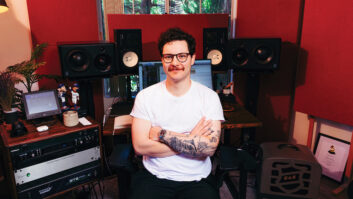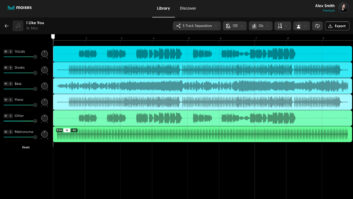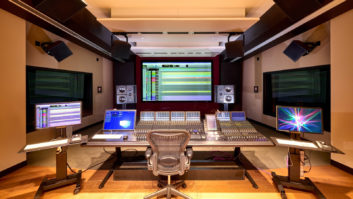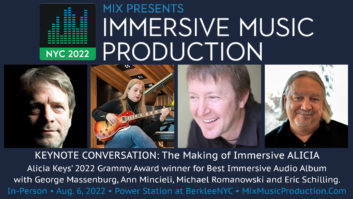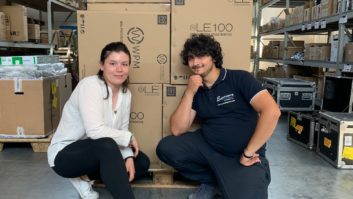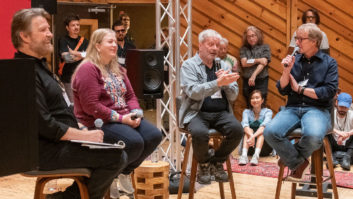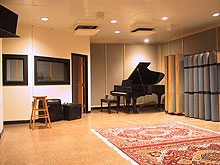
The Berklee College of Music turned 60 years old this year, and there still isn’t any school in the world quite like it. With more than 4,000 students, 12 (soon to be 16) studios, countless performance spaces and a pedigree rich in tradition yet focused on the next century, Berklee has seemingly forever been in a unique position to merge the worlds of musicianship and recording.
The Studio A tracking room
photo: Phil Farnsworth
And while it would be simple at this point to sit back and rely on the tried and true, coasting along with an international reputation and thousands of applicants, the leaders at Berklee are doing just the opposite. During the past few years, with the support of new president Roger H. Brown and the leadership of dean Stephen Croes and chairs Kurt Biederwolf and Rob Jaczko, the Music Technology Division has torn down and rebuilt its entire curricula and developed four new studios (opening this coming spring) in the soon-to-be-renamed Music Synthesis Department.
“When I came onboard, I saw so much creativity, so much activity and receptivity, it was like a volcano spewing out lava — just so much invention every day,” says Croes, who joined as dean in 2002 after a multifaceted performing and composing career in L.A. “The credit has to go to the completely remarkable engineer/educator Don Puluse, who had the vision to establish the whole Music Production & Engineering program in the 1980s.”
As dean, Croes is responsible for Music Production and Engineering, started by Puluse in 1983, and Music Synthesis, started in 1986. While students can major in any of 13 disciplines, from film composition to music therapy, music technology remains the only division where students must apply for entry. The interest is so high that only about 45 percent get into either department. While this helps keep class sizes small, the division hopes to expand facilities and allow more students.
Currently, Jaczko runs 11 studios and an edit production suite, all booked by students and open 22 hours a day, seven days a week. But that doesn’t mean that freshmen jump right on the SSL; like all things Berklee, the curriculum starts and ends with music.
“Music is the currency in which we trade,” Jaczko says, re-emphasizing that all students who get into Berklee, regardless of major, must be proficient in an instrument. “Harmony, ear training, critical listening. As much as technology is changing, with the ease of computer-based recording, so much of what we do is based on universal truths — knowing where to put a mic, thinking about dynamics, working with an acoustic space. The musical community here is what makes this all work. If someone needs to add an African frame drum at 4 in the morning, they can probably find it on campus.”
During the past two years’ curriculum review, the MP&E department focused primarily on rebalancing coursework, with an even greater emphasis on foundational skills and a deeper push into critical listening. Over in Music Synthesis, however, the changes were far more extensive, including a name change (soon to be announced).
“The music synthesis area had always been at the forefront of musical education,” Croes says, “but it was ready for a sprucing up to make it more modern and fresh. The role of producing has really changed to one of creating. Many of the students want to design compositions for video, film, games, wherever, and the tools are emerging to make that possible. We have visiting artists like BT and Gary Chang, and the students see this new model. So to honor its 20th year, we’re giving it a name change, we re-did the curriculum and we’re opening four new electronic studios.”
The studios were designed into an old Back Bay building, one Croes calls “a rat’s maze in a 1906 structure.” He enlisted the help of an old Los Angeles friend, designer Todd Wilson, whom, he says, “builds studios where you shouldn’t build studios. Perfect for this project. Just brilliant design.” After bouts of laughter at the initial walkthrough, including the discovery that the space was a former pizza bakery, the two collaborated via iSight and ended up with three Pro Tools|HD — equipped control rooms, a tracking room and a modern teaching lab.
“These kids in Music Synthesis have never had their own studio space,” Croes says. “They’ve always worked on headphones and they desperately needed an environment.”
Simultaneous to the two-year overhaul of the two departments, Berklee launched a highly successful online education program that Croes says has been a real victory for the college in outreach. The school also increased the numbers and visibility of the visiting professionals series, last year awarding the Herb Alpert Visiting Professorship to George Massenburg and hosting Elliot Scheiner, Nathaniel Kunkel and Tony Maserati, and landing John Storyk for an advanced acoustics course in 2006. Croes is already making overtures to join the Internet2 consortium so students can participate in research activities and focus on collaborations exploring immersive environments.
Still, with all the emphasis on the changing landscape of production and the creative use of technology, music is what informs everything that goes on at Berklee. “We are really an arts institute,” Croes says. “We don’t teach tools; we use tools to teach process. And we base it on the individual. A student leaving Berklee will have learned how to learn, and they will leave knowing two things: One, music is about relationships with people, and we look for partnerships that work. And two, we try to teach them how to become an artist, to embrace risk, to stay close to the art experience. We want them to leave with the core understanding of what brought them here. And that is the music.”
Tom Kenny is the editor of Mix magazine.
